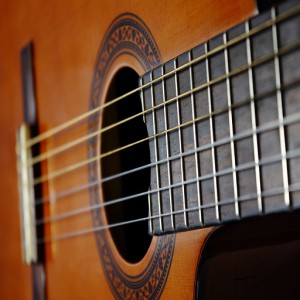It is important to know the different parts of the acoustic guitar because at some stage you may need to adequately relate to other guitar players about your instrument. The acoustic guitar consists of three main parts:
- head
- fingerboard
- body
Head
The upper end of the guitar is known as the headstock. It consists of tuning keys which are responsible for tuning the strings of the guitar. They normally have 3 strings on the top and 3 strings on the bottom. The little parts connected to the tuning keys are called the tuning pegs or string pegs. They have little eyelets where you attach the strings to the guitar.
Some guitars have a truss rod cover located in the head and in other guitars access to the truss rod is through the soundhole. If it is located in the headstock, you have to take the cover off to access the truss rod. The truss rod is responsible for putting a bow in the neck of the guitar to enable the right amount of neck relief. This will determine how low your strings are to the frets. You want your strings to be as close as possible without getting any fret buzz.
Fingerboard
The nut is the ledge at the upper end of the fingerboard over which the strings pass. It is here that the strings rest, sit in little grooves and are held steady before they go to the tuning peg. The nut is made out of plastic or bones depending on which has the best sound.
It is here that the strings rest, sit in little grooves and are held steady before they go to the tuning peg. The nut is made out of plastic or bones depending on which has the best sound.
The fretboard is the piece of wood that runs the length of the neck. It is normally glued onto the neck but sometimes is actually part of the neck.The ridges of metal running vertically across the fretboard of a guitar are called the frets. They separate the notes on the guitar and help the fingers locate notes on the strings.
Most guitars have dot inlays or fret markers. The reasons for the inlays are for decoration and to help you visualize where you are on the fingerboard. They even run along the side of the guitar so that you can see them while you are playing.
Body
The pickguard protects the guitar so that you do not scratch the guitar when you are using your pick.
The soundhole is where you produce that acoustic sound. When you hit a string you get resonance and that is due to the soundhole in the body. It can also be the access point to the truss rod of the guitar.
The bridge is usually the dark piece glued to the top of the guitar. This is where the stings attach. The white part on the bridge is called the saddle. It is made of plastic or bone and it separates the strings using tiny grooves. This is where the strings rest before they go into the hole where you insert the bridge pins into the bridge to hold the strings in place. Pin-less bridges do not have pins and the strings go in to the back of the bridge.
The acoustic electric guitars sometimes have a cutaway. The cutaway is a indentation in the lower part of the instrument adjacent to the neck of the guitar. It is designed to allow guitar players easier access to the higher frets.
